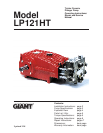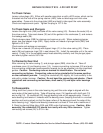
Supplementary Plant Lay-Out Instructions - LP121HT PUMP
Pressure in Inlet Side
The stipulated NPSHR is the minimum required pressure above the vapor pressure of the
medium and is never to fall short of this figure. Temperature and vapor pressure of the
medium, the geodetical height of the location, the flow rate and the loss of friction in the
suction line, must all be taken into consideration. It may be necessary to install a booster
pump (centrifugal) in the suction line.
Pulsation
Due to its construction, the plunger pump creates pulsation in the inlet and discharge lines.
In particular, inlet pulsation must be dampened in order to prevent resonance in the suction
line which in turn causes cavitation. Therefore, the pump is never to be connected by a
rigid pipe. Rather, use a flexible hose, which is not reinforced by steel, that is 1.5 to 2
times wider than the inlet port. If a booster pump is used, the hose is to be attached
between the booster pump and the high pressure pump.
If several pumps are used, each pump must have its own inlet line. If this cannot be done,
an inlet air chamber or inlet flow stabilizer must be installed in front of each pump. The
bladder in the stabilizer is to be pre-tensioned on location.
Depending on the layout of the plant, a pressure accumulator may be necessary on the
discharge side. The pressure accumulator must be installed right behind the discharge
outlet of the high pressure pump. Only use one pressure accumulator (in the discharge
line) at a time in order to avoid irritation which could be caused by different pretension
levels in the accumulators.
Gas-tension in both the inlet flow stabilizer and the pressure accumulator are to be
checked regularly.
6










